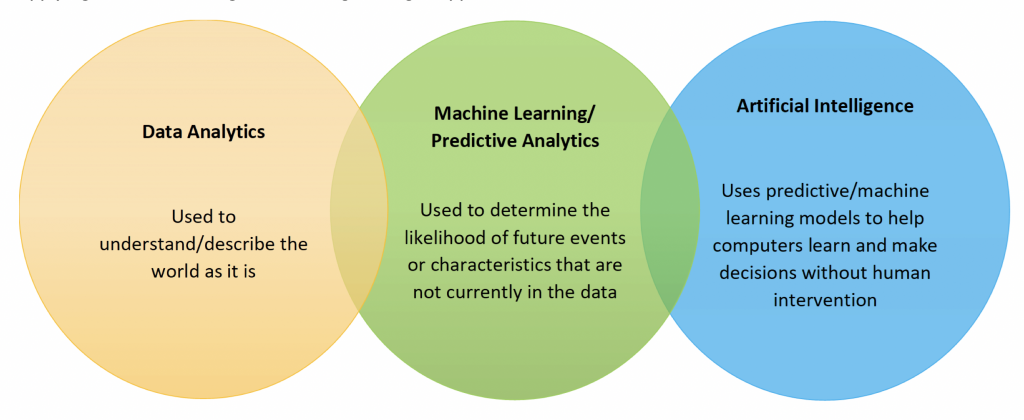Unpacking the Hype: Making Sense of Predictive Analytics, Machine Learning and AI in Market Insights
If you’re like me, you’re probably reading this link because of the buzzwords in the title. Even though everyone seems to be talking about predictive analytics, machine learning and AI, definitions for these emerging fields can be hard to come by and, more importantly, few people have a clear vision for how they can benefit their businesses. In this post, we will bring clarity to this topic and give you some ideas for how these emerging fields can be used to benefit your business.
Starting at the Beginning: Data Analytics
We can’t have a conversation about machine learning and AI without first talking about data analytics. This is because, to some degree, both machine learning and AI either are based on data analytics or actually are data analytics. So, what do we mean by “data analytics?” For the purpose of this post, we define data analytics as deriving insights from data – specifically, from data that is collected via means other than “traditional” market research. This could include purchase history, customer feedback on 3rd party websites, and so on. As you can see, this casts a wide net – nearly any analysis can be considered data analytics. So, where do predictive analytics, machine learning and AI fit in?
Meet the Twins: Predictive Analytics and Machine Learning
In An Introduction to Statistical learning, the authors argue that analyses are done for one of two reasons: for inference and for prediction.
Analysis for Inference
- Focuses on describing relationships
- Helps us understand how the world works
- Example: Using ad spend and sales data to identify the most effective ad channels.
Analysis for Prediction
- Focuses on knowing something that’s not currently in the data
- Helps us understand what something is or what will happen in the future
- Example: Predicting the likelihood that a customer will renew his or her subscription using historical transaction data
The reason predictive analytics and machine learning are twins is that both are used for making predictions. In fact, when people refer to predictive analytics and machine learning, they’re often referring to the same thing (though sometimes not – which we’ll explain shortly). Predictive models can take many forms ranging from regression techniques, to clustering algorithms, to more sophisticated models like neural nets or boosted models. In short, all these analytic tools are used for knowing something that isn’t observed in the data. Where predictive analytics and machine learning can differ are in the specific techniques that people refer to when using these terms. For instance, when speaking of predictive analytics, people are often referring to more traditional, though potentially less accurate, techniques like regression or time series analysis. Machine learning, on the other hand, typically refers to more recent developments in predictive modeling like boosted models or neural nets. These techniques are more complicated and require more data, but are also more accurate than traditional methods.
The Machines are Alive! Artificial intelligence and Machine Learning
We should start by pointing out that the definition of AI is the topic of much debate. However, for the purpose of this post, we’ll define AI as the process of teaching a computer to learn from data and act based on what it has learned – in essence, to learn and act with minimal human intervention. In most cases, this process is driven by predictive/machine learning models. Thinking back to the example of whether someone will renew a subscription, if you want your online systems to identify customers that likely won’t renew and then automatically send them a special offer, you’d want to look into an AI solution.
Applying it to market insights: Choosing the Right Approach

So which one do you need? The answer is
found through understanding: 1. Why are you conducting the analysis? and 2. How
will the results be used? To this end, here are some guidelines for each.
Data Analytics (i.e. analytics for inference)
Good if...
- The goal is to make large-scale, strategic decisions
- You are at a phase in a project where understanding the problem is key
Predictive Analytics/Machine Learning
Good if...
- You need to understand what will happen in the future (i.e. project revenue, customer turnover, etc.)
- You want to determine a characteristic of your customers that is not currently measured in your data (i.e. segment membership, phase in purchase cycle, etc.)
- You have a good understanding of the problem and want to act strategically to promote a specific future outcome for individual customers (e.g. increase the probability of a sale, decrease the likelihood of leaving, etc.)
Artificial Intelligence
Good if...
- You have a good understanding of the problem, you have a large quantity of data, and you want to automate the process to save cost or reduce time spent on the task
Have a data problem that you’re struggling to solve? Feel free to reach out to us at robertv@phase-5.com.

Author: Robert Vagi
Robert Vagi, PhD, is Phase 5’s lead data scientist. Drawing from his background in both quantitative research and education, Rob is passionate about helping clients use data to tackle their most challenging business problems. Throughout his career, he has helped clients in both private and public sectors make the most of their data. This work has received both local and national media attention. Rob is based in Minneapolis, MN.